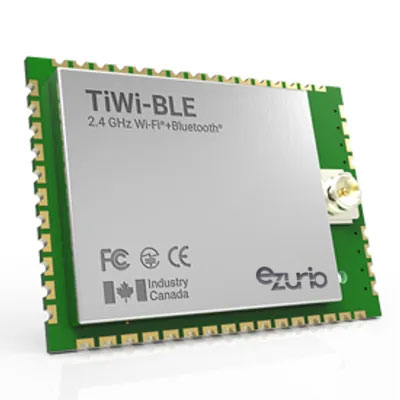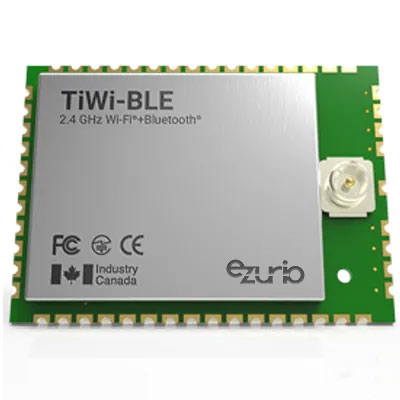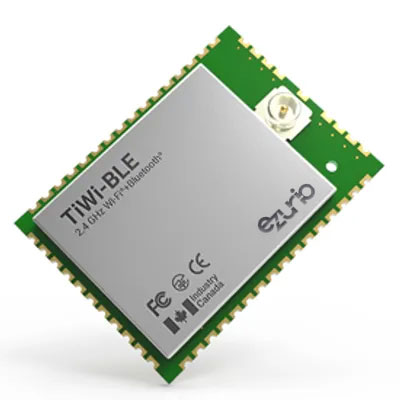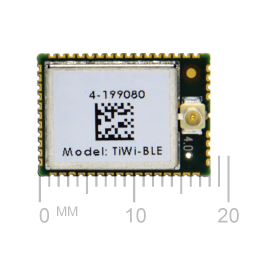TiWi-BLE
TiWi-BLE
End of Life (EOL)

5 Photos
Overview
Bluetooth Classic & Bluetooth Low Energy + Wi-Fi 802.11 b/g/n Module
The TiWi-BLE Bluetooth and Wi-Fi combo module is a high performance 2.4 GHz WLAN IEEE 802.11 b/g/n, Bluetooth 2.1+EDR and Bluetooth 4.0 (Bluetooth Low Energy) radio in a cost effective, pre-certified footprint.
The module realizes the necessary PHY/MAC layers to support WLAN applications in conjunction with a host processor over a SDIO interface.
The module also provides a Bluetooth platform through the HCI transport layer. Both WLAN and Bluetooth share the same antenna port.
Buy Now
Development Kits
Specifications
Certifications
FCC, ISED, EU, MIC
Compliance
RoHS compliant
Dimensions (H x L x W)
1.9 mm x 18 mm x 13 mm
Interfaces - General
SDIO (WLAN), UART, and Advanced Audio Interface (Bluetooth)
Line
Professional
Operating Temp (°C)
-40 °C - +85 °C
Output Power
280 mA, 11 Mbps, CCK (b)
185 mA, 54 Mbps, OFDM (g)
165 mA, 65 Mbps, OFDM (n)
185 mA, 54 Mbps, OFDM (g)
165 mA, 65 Mbps, OFDM (n)
Receive Sensitivity
-89 dBm, 8% PER, 11 Mbps, CCK (b)
-76 dBm, 10% PER, 54 Mbps, OFDM (g)
-73 dBm, 10% PER, 65 Mbps, OFDM (n)
-76 dBm, 10% PER, 54 Mbps, OFDM (g)
-73 dBm, 10% PER, 65 Mbps, OFDM (n)
Transmit Power
20.0 dBm, 11 Mbps, CCK (b)
14.5 dBm, 54 Mbps, OFDM (g)
12.5 dBm, 65 Mbps, OFDM (n)
14.5 dBm, 54 Mbps, OFDM (g)
12.5 dBm, 65 Mbps, OFDM (n)
Voltage
3.0 V to 4.8 V
Wi-Fi Chipset
TI WL1271L
Wi-Fi Spec
b/g/n
Wireless Specification
IEEE 802.11 b/g/n
Bluetooth 2.1+EDR, Class 1.5
Bluetooth 4.0 (BLE)
Bluetooth 2.1+EDR, Class 1.5
Bluetooth 4.0 (BLE)
Part Number
| Price @ 1k
| Antenna Type
| Chipset (Wireless)
| Description
| Frequency Range (Max)
| Frequency Range (Min)
| Logical Interfaces
| OS/Software
| Product Type
| System Architecture
| Technology
|
|---|---|---|---|---|---|---|---|---|---|---|---|
450-0064 EOL Buy Options | N/A | External | TI WL1271L | TiWi-BLE wtih U.FL Connector, Tray | 2495 MHz | 2400 MHz | SDIO, Serial, I2C | HCI | Embedded Module | Hosted | 802.11bgn, Bluetooth 4.0, Dual Mode (Classic + BLE) |
450-0064R EOL Buy Options | N/A | External | TI WL1271L | TiWi-BLE with U.FL Connector, TR | 2495 MHz | 2400 MHz | SDIO, Serial, I2C | HCI | Embedded Module | Hosted | 802.11bgn, Bluetooth 4.0, Dual Mode (Classic + BLE) |
Documentation
Datasheet 1 total
Name |
Part |
Last Updated |
|---|---|---|
| TiWi-BLE Datasheet | All | 09/05/2024 |
Software 9 total
Name |
Part |
Last Updated |
|---|---|---|
| Bluetooth Eval Tool | All | 03/29/2019 |
| Bluetooth Patch File: ETSI BT 4.0 all certified antennas | All | 03/29/2019 |
| Bluetooth Patch File: FCC/IC/ETSI BT 2.1 + EDR, FCC/IC BT 4.0 all certified antennas | All | 03/29/2019 |
| Bluetooth Patch File: Used with the Bluetooth Eval Tool | All | 03/29/2019 |
| WLAN and Bluetooth Radio Tools User Guide | All | 05/01/2019 |
| WLAN Eval Tool | All | 03/29/2019 |
| WLAN Firmware for use with WLAN Eval Tool only | All | 03/29/2019 |
| WLAN INI: ETSI all certified antennas | All | 03/29/2019 |
| WLAN INI: FCC/IC LSR Dipole & Ethertronics antennas | All | 03/29/2019 |
Documentation 6 total
Name |
Part |
Last Updated |
|---|---|---|
| PCN 12C-2021 - TiWi5 and TiWi-BLE | All | 01/11/2022 |
| TiWi Antenna Design Guide | All | 03/29/2019 |
| TiWi EMC Compliance Guide | All | 03/29/2019 |
| TiWi-BLE EOL Notice | All | 03/27/2019 |
| TiWi-BLE Support & Tools | All | 03/30/2019 |
| TiWi-R2,BLE,5 Design Considerations | All | 03/29/2019 |
Certification 4 total
Name |
Part |
Last Updated |
|---|---|---|
| EU Certifications - TiWi-BLE | All | 06/18/2021 |
| FCC and ISED (Canada) Certifications - TiWi-BLE | All | 12/19/2020 |
| MIC Certifications - TiWi-BLE | All | 01/13/2023 |
| Regulatory Information - TiWi-BLE | All | 03/17/2023 |
Technical Drawings 3 total
Name |
Part |
Last Updated |
|---|---|---|
| 3D Models CAD Downloads TiWi-BLE with U.FL Connector (2-20-2013)(450-0064) | All | 03/28/2019 |
| SCH/PCB Models CAD Downloads TiWi-BLE with RF Castellation (2-15-2012) | All | 03/28/2019 |
| SCH/PCB Models CAD Downloads TiWi-BLE with U.FL Connector (2-15-2012)(450-0036) | All | 03/28/2019 |
Quality and Environmental 5 total
Name |
Part |
Last Updated |
|---|---|---|
| Conflict Minerals Statement | All | 08/09/2024 |
| EU RoHS (2011/65/EU) | All | 03/29/2019 |
| Reach Chemical Analysis | All | 03/29/2019 |
| RoHS Test Report | All | 03/28/2019 |
| WEEE Statement | All | 03/29/2019 |
Become an Ezurio Customer to Gain Exclusive Access to Our Design Experts
- Antenna Scans
- Antenna selection and placement
- Custom antenna design
- Worldwide EMC testing / certifications
- Embedded RF hardware / firmware design
- Cloud architecture and integration
- Mobile application development
- Product & Industrial Design
Distributors
| Distributor | Phone Number | Region | Website |
|---|---|---|---|
| Arrow Electronics | 1-855-326-4757 +44 2039 365486 |
APAC, North America, South America, EMEA | Website |
| Braemac Australia, New Zealand, South East Asia | +61 2 9550 6600 +64 9 477 2148 |
APAC | Website |
| DigiKey | 1-800-344-4539 |
North America, South America, APAC, EMEA | Website |
| EBV Elektronik | EMEA | Website | |
| Farlink Technology China, Hong Kong | +86 13266922199 |
APAC | Website |
| Farnell | 1-800-936-198 +44 3447 11 11 22 |
EMEA | Website |
| Future Electronics | 1-800-675-1619 1-514-428-8470 |
North America, South America, APAC, EMEA | Website |
| Glyn | +49-6126-590-0 |
EMEA | Website |
| Hy-Line Germany Only | +49 89 614 503 0 |
EMEA | Website |
| Jetronic China, Hong Kong and Taiwan | 852-27636806 |
APAC | Website |
| M2M Germany | +49-6081-587386-0 |
EMEA | Website |
| Martinsson | +46 8 7440300 |
EMEA | Website |
| McCoy South East Asia | +65 6515 2988 |
APAC | Website |
| Mouser Electronics | 1-800-346-6873 +44 1494 427500 |
North America, South America, APAC, EMEA | Website |
| RS Components | +852-2421-9898 +44 3457-201201 |
North America, South America, APAC, EMEA | Website |
| Ryoyo Japan | +81-3-3543-7711 |
APAC | Website |
| Solsta UK Only | +44 (0) 1527 830800 |
EMEA | Website |
| Supreme Components International India, South East Asia | +65 6848-1178 |
APAC | Website |
| Symmetry Electronics | 1-866-506-8829 |
North America | Website |
| Tekdis Australia and New Zealand | +61 3 8669 1210 |
APAC | Website |
| Telsys | +972 3 7657666 |
EMEA | Website |
| WPG | +44 1628 958460 |
EMEA | Website |
 Laird Connectivity is now Ezurio
Laird Connectivity is now Ezurio




/filters:background_color(white)/2024-10/tiwi-ble-smart-ready-wifi-bluetooth-module-left1.jpg)